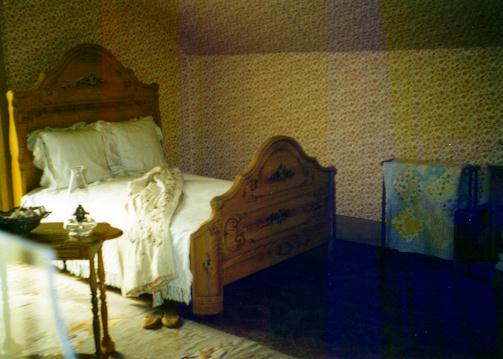|
Imagine entering the kitchen door to be greeted not by a family member or a servant, but by a parrot! Polly the parrot frequently invited visitors into the kitchen.
 The kitchen table-covering was hand woven by Mrs. Rothschild's parents, and depicts a scene of their home, the city of Goslar, Germany.
The kitchen table-covering was hand woven by Mrs. Rothschild's parents, and depicts a scene of their home, the city of Goslar, Germany.
Running water became a luxurious addition to this kitchen when the original pump was moved from the cistern, just outside the kitchen door, to where you see it today. Cooking utensils and serving pieces used by the family and the Chinese cook, Foo Chong, are seen around the wood burning stove and in the pantry.
Dining Room
Not being satisfied to sit in the kitchen, Polly often sat in the dining room to be with family and guests. Notice the claw marks on the chair by the kitchen door!
 Family meals were always served in the dining room, with many guests often included. Ship captains, businessmen, and friends were frequently seen at the Rothschild House table.
Family meals were always served in the dining room, with many guests often included. Ship captains, businessmen, and friends were frequently seen at the Rothschild House table.
Goslar, Germany (1844) appears again in the gold-framed lithograph between the windows, reminding Mrs. Rothschild of her beloved homeland.
Guest Bedroom
Mr. Rothschild's ship chandlery business attracted mariners from all over the Pacific Rim. Many ship captains and officers undoubtedly used this guest room for the night, bringing with them gifts from Japan, China, or other exotic countries.
The convenience to the bathroom and heat source made this a cozy place for the most important guest. The door to the left leads to the bathroom which oritinally contained only a wash basin and zinc-covered bathing tub. The outhouse was behind the house by the driveway.
The Rothschild business, "The Kentucky Store", carried more than just ship's supplies. The unique Florence sewing machine was one such item. This particular machine was used to make many clothes for the family of five children.
 Regina Rothschild was married to William W. Jones in this house in 1891. Her wedding portrait, taken in Seattle, is seen here. Mrs. Bly, her daughter, said this about the portrait:
"She was seasick all the way, so the little smile is being forced."
Regina Rothschild was married to William W. Jones in this house in 1891. Her wedding portrait, taken in Seattle, is seen here. Mrs. Bly, her daughter, said this about the portrait:
"She was seasick all the way, so the little smile is being forced."
The other three pictures show the wedding party and decorations in the parlor and dining
room with gifts in the sewing room. For the celebration, electricity was brought to the |
house for a "light show" that drew the attention of the community.
Mr. Rothschild's desk, which was used in the Kentucky store and later in the shipping business, is made of mahogany and stained with a walnut finish.
Douglas fir was used for most of the woodwork in the house. It was hand stained to give the appearance of oak, a hardwood not locally available. The stairway banister is made from solid mahogany which was molded and curved using a steam process to soften the wood for shaping.
Parlor
Port Townsend harbor was a busy seaport in the 19th century. Someone must have sat by the window rocking and watching the harbor activity. Notice the worn spot in the carpet under the wicker chair to your left. Ninety percent of the furniture in this house belonged to the Rothschild family and nearly all was purchased between 1860 and 1886.
The wallpaper in the entry hall was installed in 1885, but in all other rooms the paper is more recent. Heat was provided by the back-to-back coal burning fireplaces.
 Even though the parlor was rarely opened, it was used on special occasions. Three Chinese fans and the vase of carved bamboo were common in Port Townsend due to direct trade with China. Entertainment was provided for the guests with music from the piano, singing, and even a "slide show". The stereoptican gives an illusion of three dimensional depth to photographs.
Even though the parlor was rarely opened, it was used on special occasions. Three Chinese fans and the vase of carved bamboo were common in Port Townsend due to direct trade with China. Entertainment was provided for the guests with music from the piano, singing, and even a "slide show". The stereoptican gives an illusion of three dimensional depth to photographs.
A traveling artist drew the charcoal portrait of David Charles Henry Rothschild in 1873.
Outside
It is hard to re-create the atmosphere of the 1800's with the hustle and bustle of the 21st century encroaching all around. But given only a half-acre to try, Rothschild House comes close. The rose garden is a delightful retreat on a summer afternoon. The herb garden still produces dozens of typical kitchen garden treats.

Imagine if you can the view from the front porch out over a brand new town, with all of its hopes and dreams, bustling as a key seaport and gateway to Puget Sound. The Rothschild's store is one of the many businesses on Water Street below.
This house was a home and a haven to the family. Here they celebrated life, raised their family, planned for their thriving business, and entertained guests from around the world. Raising the flag with forty-four stars on a Fourth of July celebration in the late 1800's is reminiscent of family holidays today, one hundred years later. In this photo, the house can be seen to the right, the well on the lower left. |



